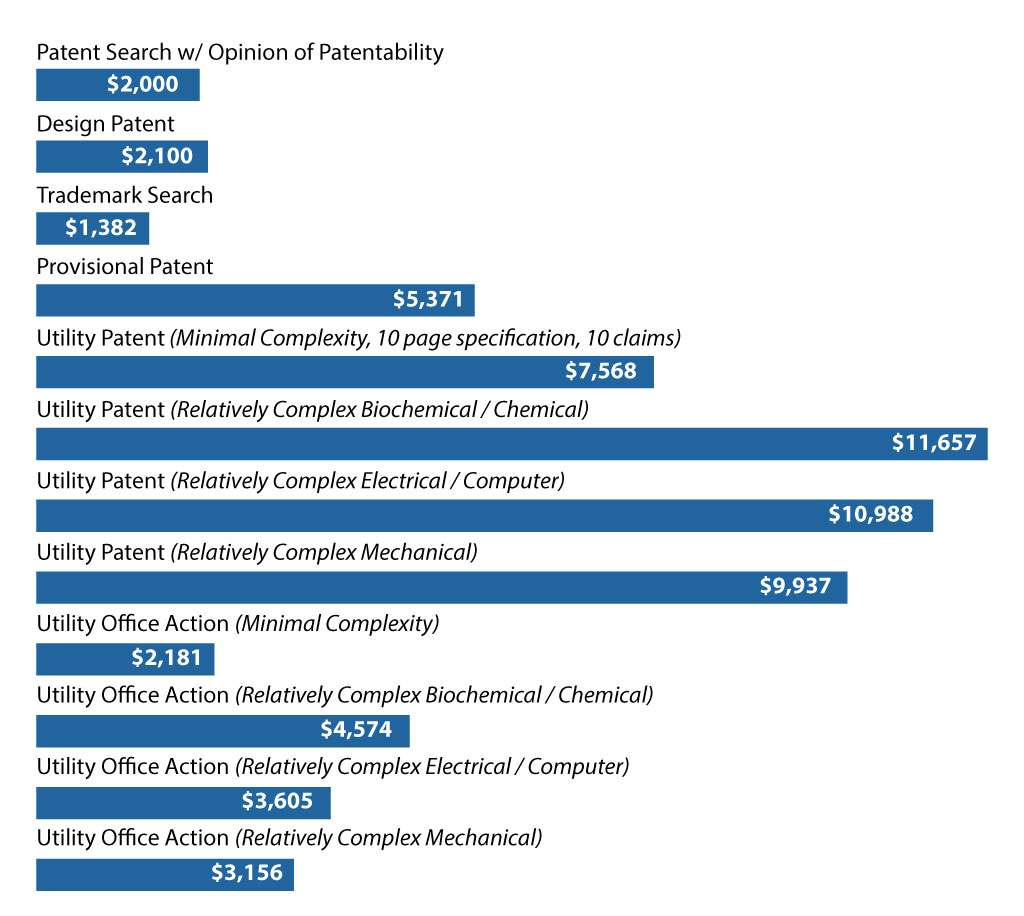How Much Does A Patent Cost?
In working and being around inventors for the past 20 years, the most common question that every inventor wants to know right away of course is: How much does a Patent cost?
This is a completely reasonable question because you know that you have a great idea, spent time to develop it, and think you are ready to pursue a patent… but at what cost? If you’ve ever tried to research the patent price range online, you likely got discouraged after 3 or 4 Google results pages telling you “well, it depends.” Don’t give up just yet. This article will help you learn about the details of patent pricing, whether DIY patents or a low cost patent is worth the effort, how to choose the best patent type for your needs and what you can do to prepare and save on patent expenses.
With the wide range of patent options out there, please share any feedback, thoughts or experiences you have had with patenting to shine more light on this topic.
“So, How Much Does a Patent Cost?”
At the most recent Hardware Show in Las Vegas, I asked several inventors who were exhibiting if they got a patent on their invention and if they wouldn’t mind sharing what they spent for it. Interestingly, everybody I talked with did get patent protection for their product. Even more interesting, nobody was even close to each other when it came to cost. The range went from $400 all the way to over $20,000. How is this even possible you’re probably asking? Me too. Hopefully the rest of this article helps give you some perspective as to why there can be such significant differences in price when it comes to patents.
One thing is for sure, Americans absolutely want to know the answer to this question as the Google search phrase “How much does a X cost?” reveals that the thing we Americans want to know the price of more than anything in the known universe is how much does a patent cost. Comparing us with the rest of the world, other countries are much more interested in the price of camels, funerals, houses, and even beer than what the average cost of a patent will set them back. This speaks volumes about where we are as a nation versus under-developed countries who are still concerned about basic life necessities.
The best way I know to answer this question properly in broad terms is by revealing the median results of the American Intellectual Property Law Association (AIPLA) 2021 Report of the Economic Survey. (The AIPLA is an association of attorneys specializing in patent law.) This is a report where the AIPLA combines and averages the prices of various sized intellectual property firms across the country who provided their charges for the items listed below:

As you can see, simply getting started with the patent process utilizing the services of an IP attorney requires a significant investment for the average individual in the United States. The biggest contributing factor is that the mean cost per hour of a patent attorney is $330, per the AIPLA, and some fees can go as high as $600 or more per hour. Your invention’s complexity, patent type requested, and which firm you choose will directly affect the amount you’re charged for patent services. All of these charges are only for the services of a licensed patent professional and do not include any government fees.


How to Save Money Navigating the Patent Price Range
Whether you’re creating a new software program or a physical product, understanding how the patent process works and the costs associated with it is the best way to choose which option is right for you. The factors listed below directly affect the patent price range, or patent cost. The more detailed information that you can provide for any of these steps would reduce the time needed to prepare your application which should directly affect your cost (as long as you’re being billed hourly).
- Type of patent application and scope. The total cost of a patent is affected by the type of patent filed and its scope. A provisional patent application may cost less than a nonprovisional patent, but only initially as much more research and preparation are required before the latter must be filed. Also, if your invention would benefit from international protection, you may need to file an international patent application, otherwise known as a Patent Cooperative Treaty (PCT) patent application, versus U.S. only. Filing a PCT patent application involves more in-depth research, substantial government filing fees and more attorney costs which will ultimately be thousands of more dollars for your patent protection.
- Patent search with opinion. Performing a patent search on your own is always a good first step, but obtaining a patent search with opinion of patentability by a licensed practitioner acts as insurance for you as you decide whether to pursue patent protection. In fact, the USPTO (in this less than easy to understand flowchart) recommends starting with a Patent Search before moving forward with the patent process.
- Government Fees and Entity Status. The majority of individual inventors are considered a micro entity when applying for patents which saves them 75% on government fees vs large entities that are mainly for-profit brands or those with multiple patents. To qualify for micro-entity status, an inventor, among other things, needs to earn less than 3X the median household income which is roughly $155,000 as of the time of this writing. Inventors earning more than that amount still get a discount of about 50% vs. large entity inventors. To put this in perspective, a micro entity’s filing fee for a non-provisional utility patent is $400, a small entity is $730 and $1600 for large entities. To learn more about micro entity income requirements, check out the USPTO website here. Here is a link to all of the various Government fees by the USPTO that may or may not apply to your situation.
- Complexity of the invention. Varying degrees of complexity exist when evaluating an invention. For example, filing a patent for an extremely simple invention, such as a coat hanger, will be less expensive than performing the same process for a complex diagnostic device or software program. As the complexity of your invention increases, so will the cost to obtain a patent.
- Engineering Specification. Your patent needs to be written with enough detail so that someone skilled in the field of your invention can simply take your patent and go make your invention. Because the patent requires this level of specific information, an engineer will often be needed to draft the specification for the patent to satisfy this requirement. Again, the complexity of the invention really affects how much more or less “engineering” will be needed.
- Patent Drawings. In the United States, patent drawings are required to be filed with your application in order to fully understand the invention. Since design patents protect how a product looks, 6 drawings or more are usually needed in order to see the invention from all sides. Depending again on the size and complexity of the invention, more or less drawings will be needed in order to fully illustrate what the invention looks like and does.
- Attorney involvement. Because attorney fees are generally the bulk of the patent cost, some inventors consider omitting legal help altogether. When compared with the initial costs of DIY patents, traditional patents involving an attorney will involve more expense. However, because intellectual property attorneys have in-depth knowledge of the patent application process and know how to professionally prepare an appropriate application, you can rest easy knowing you’re legally protected. Like everything else in life, you do get what you pay for when it comes to patenting.
Though not the end-all list of all patent costs, the above factors play a large role in determining what you’ll ultimately pay to apply for a patent.
DIY Patents: Are They Right for You?
As mentioned previously, it is possible to search for patents and complete the application yourself. Some inventors feel that they are the best person to explain the technical aspects of an invention anyway, so why pay someone else? Before choosing this option, consider the drawbacks of DIY patents.
- Nailing the claims section. Though most inventors believe the technical aspect of their invention is the most important when filing a patent application, professionals know it’s truly the claims section that carries the bulk of legal weight. Failure to complete this section properly leaves inventors and their creations vulnerable in matters of infringement and validity ultimately costing the inventor everything.
- Mastering legal language. For those without a legal background, legalese seems like an entirely new language. If patent applications aren’t filed with meticulous attention to every word therein, inventors ultimately suffer the consequences when their application is reviewed with a fine-tooth comb.
- Post-filing risks. Completing a patent application is intended to uncover similar patents, pending lawsuits or litigation involving other inventions, and bring other agreements and contracts to light. If information is missing or incomplete once reviewed by a patent officer, your patented invention may not have enough legal weight to prosecute claims against similar products.
Filing a patent application yourself might avoid steep attorney fees in the beginning, but will most likely not offer you any real protection. In the event of litigation, a self-filed patent is at risk of severe scrutiny by any legal entity and may not hold its weight if a similar invention comes along. If the invention is as good as you think it is, you should expect copycats to hit the market soon after launch. For inventors, this could mean loss of equity in their invention and inability to access legal recourse should a competitor enter the market.
Is the Patent Cost Worth It?
This can really only be determined by the inventor. Nobody is going to hold a gun to your head and force you to get a patent on your invention. Some inventors avoid the patent route altogether and just start marketing their invention. The major question you need to ask yourself is, “Would you mind someone else copying and profiting off of your invention idea for free?”
If that answer is yes, try to determine how much money you can generate from the patent and see if it covers your patenting cost. That would be a good place to start. For some, success isn’t defined by money and getting an issued patent is on their bucket list? Use our patent calculator below to determine what the average cost is for your invention.








